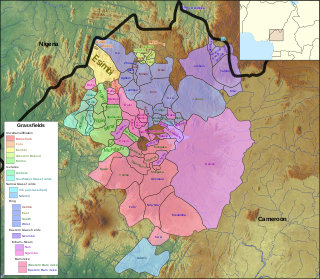Related Research Articles

Sandawe is a language spoken by about 60,000 Sandawe people in the Dodoma Region of Tanzania. Sandawe's use of click consonants, a rare feature shared with only two other languages of East Africa – Hadza and Dahalo, had been the basis of its classification as a member of the defunct Khoisan family of Southern Africa since Albert Drexel in the 1920s. Recent investigations however suggest that Sandawe may be related to the Khoe family regardless of the validity of Khoisan as a whole. A discussion of Sandawe's linguistic classification can be found in Sands (1998).

The Shan language is the native language of the Shan people and is mostly spoken in Shan State, Myanmar. It is also spoken in pockets in other parts of Myanmar, in Northern Thailand, in Yunnan, in Laos, in Cambodia, in Vietnam and decreasingly in Assam and Meghalaya. Shan is a member of the Tai–Kadai language family and is related to Thai. It has five tones, which do not correspond exactly to Thai tones, plus a sixth tone used for emphasis. The term Shan is also used for related Northwestern Tai languages, and it is called Tai Yai or Tai Long in other Tai languages. Standard Shan, which is also known as Tachileik Shan, is based on the dialect of the city of Tachileik.
Vengo, or Babungo, is a Grassfields language and the language of the Vengo people from the village of Babungo in the Cameroonian Grassfields. The spelling Bamungo is also often found.
The Kom language is the language spoken by the Kom people in Northwest Province in Cameroon. It is classified as a Central Ring language of the Grassfields, Southern Bantoid languages in the Niger-Congo language family. Kom is a tonal language with three tones.
Kera is an East Chadic language spoken by 45,000 people in Southwest Chad and 6,000 people in North Cameroon.
Nso is the Grassfields language of the Nso people of western Cameroon. A few may remain in Nigeria. It has ten major noun classes. The ISO 639-3 code is lns. Nso is spoken by over 100,000 people.
Iau or Turu is a Lakes Plain language of West Papua, Indonesia, spoken by about 2,100 people, native speakers of this language are the Turu people (Iau). Most speakers are monolingual, and their number is growing. Other peoples in the western Lakes Plain area speak basic Iau. Iau is heavily tonal, with 11 tones on nouns and 19 simple and compound tones on verbs.
Lagwan (Logone) is a Chadic language spoken in northern Cameroon and southwestern Chad. Dialects include Logone-Birni and Logone-Gana.
Bana is an Afro-Asiatic language spoken in northern Cameroon. Dialects include Gamboura and Gili.
Kemezung is a Southern Bantoid language of Cameroon. According to Ethnologue, it's 85% lexically similar to Bebe.
Oku is a Grassfields Bantoid language that is primarily spoken by the Oku people of northwest Cameroon, a fondom of the Tikar people. They are a different ethnic group from the Oku people of Sierra Leone.
Limbum is a Grassfields language of Cameroon, with a small number of speakers in Nigeria. It is used as a trade language by some, but is primarily the mother tongue of the Wimbum people, who live in Donga-Mantung division of the Northwest Region, at the top of the Ring Road.
Ndemli, or Bandem, is a language of Cameroon spoken primarily in the Nkam department of the Littoral Region; between Yabassi, Yingui and Nkondjock. Recent classifications such as Nurse (2003) place it in with the Narrow Grassfields languages, though Ethnologue does not reflect this. Ethnologue states that it is "related to Tikar" and that "the Bandobo dialect of Tikar is very similar to Ndemli", though it is not clear if Bandobo actually is Tikar.
The Bamunka language, ŊgieməkɔʼkəBamunka pronunciation:[ˈŋgiěꜜmə́ˌkɔ̀ʔkə̌], is a Grassfields Bantu language of Cameroon.
Kenswei Nsei (Kensense), also Nsei or Mesing (Bamessing), is a Grassfields Bantu language of Cameroon.

Babanki, or Kejom, is a Bantoid language that is spoken by the Babanki people of the Western Highlands of Cameroon.
The Bambalang language, also called Chrambo or Mbawyakum (Mboyakum), is a Grassfields Bantu language of Cameroon.
Wano is a Papuan language of the Indonesian province of Central Papua.
The Baba language, Supapyak’, is a Grassfields Bantu language of Cameroon.
Medumba phonology is the way in which the Medumba language is pronounced. It deals with phonetics, phonotactics and their variation across different dialects of Medumba.
References
- ↑ Mmen at Ethnologue (18th ed., 2015) (subscription required)
- ↑ Björkestedt (2010 :9)
- ↑ Björkestedt (2010:11)
- ↑ Björkestedt (2010:52)
- ↑ Björkestedt (2010 :31)
- 1 2 Björkestedt (2010:32)
- ↑ Björkestedt (2010:32–33)
- ↑ Björkestedt (2010:33)
- ↑ Björkestedt (2010 :36)
- ↑ Björkestedt (2010 :44)